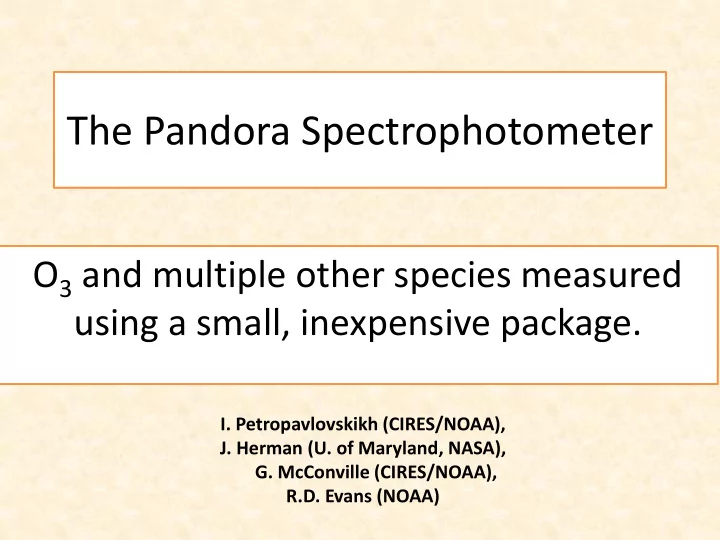

The Pandora Spectrophotometer O 3 and multiple other species measured using a small, inexpensive package. I. Petropavlovskikh (CIRES/NOAA), J. Herman (U. of Maryland, NASA), G. McConville (CIRES/NOAA), R.D. Evans (NOAA)
What is the Pandora? A small commercially available spectrometer optimized for detection of trace gases in the 280 – 525 nm spectral range, with 0.5 nm resolution, 4.5x oversampling) The “Detector” connected by optic cable to an optical head (1.6 O field of view) mounted on a high precision (0.01 O ) sun-sky tracker. 5/22/2014 GMAC, May 20-21 2014, Boulder, CO 2
Recent Usage of Pandora • The package is designed primarily for field campaigns - NASA’s Discover-AQ (several aircraft based campaigns to improve the use of satellites to monitor air quality for public health and environmental benefit.) • This summer DISCOVER-AQ and FRAPPE are in Colorado. • Instruments operated in monitoring mode, i.e. NASA Goddard, Finland, Korea, Taiwan and at the University of Alaska. 5/22/2014 GMAC, May 20-21 2014, Boulder, CO 3
What can you get from these spectral measurements? • O 3 Total Column Species of interest for the Profiles planned Boulder area • NO 2 Total Column Profiles of NO 2 and O 3 obtained at • SO 2 other sites Possible, not processed for Boulder as there • H 2 O is not enough concentration of these species • HCHO locally. • O 2 O 2 • BrO • AOT(?) 5/22/2014 GMAC, May 20-21 2014, Boulder, CO 4
4/10/2014 OWV group meeting 5
4/10/2014 OWV group meeting 6
Difference in Pandora over two consecutive days in December 4/10/2014 OWV group meeting 7
Infamous Polar vortex? http://www.wunderground.com/news/polar-vortex-plunge-science- behind-arctic-cold-outbreaks-20140106 5/22/2014 GMAC, May 20-21 2014, Boulder, CO 1.8
5/22/2014 GMAC, May 20-21 2014, Boulder, CO 9
Zoomed in on three days Select time- coincident Pandora and Dobson measurements 5/22/2014 GMAC, May 20-21 2014, Boulder, CO 10
Dobson/OMI vs Pandora offset 5/22/2014 GMAC, May 20-21 2014, Boulder, CO 11
The differences were expected, as both instruments use algorithms with a fixed stratospheric ozone weighted temperature. For the Dobson, the static temperature is 46C, sensitivity is -0.13%/DegC • For the Pandora, the static temperature is 48C, sensitivity is +0.33%/DegC • Using Richard D. McPeters and Gordon J. Labow’s Climatology 2011: An • MLS and sonde derived ozone climatology for satellite retrieval algorithms 5/22/2014 GMAC, May 20-21 2014, Boulder, CO 12
A step further: Ozonesondes • We have weekly ozonesondes, retrieving ozone and temperature profiles. • Using that information, the difference on a individual day can be predicted. 5/22/2014 GMAC, May 20-21 2014, Boulder, CO 13
The pattern in the differences are suggested by the Stratosphere Temperature 5/22/2014 GMAC, May 20-21 2014, Boulder, CO 14
Boulder, CO, 17 Dec2013-24 Mar2014 - Matched Pan, Dob and OMI O3 compared, 15 Minutes max difference in time, but with Dobson and Pandora results adjusted using McPeters and Labow’s Climatology 2011… Pandora 0.2% higher than Dobson, and OMI The standard deviation of 3.0% for OMI and 1.6% for Dob differences 5/22/2014 GMAC, May 20-21 2014, Boulder, CO 15
What have we learned in 4 months? The difference between Dobson and Pandora derived total column ozone • strongly depends on the stratospheric temperature variability. – Using ozone and temperature climatological mean profiles reduces the average Pandora-Dobson difference to ~0.2% . Potential for automated operations is considered • – This instrument survived the Boulder winds, but control computer had problems with outside temperature below approx -10C. – The longevity of the tracker head, and the neutral density filter stability is unknown. The instrument could be used as a replacement for Dobson instruments at NWS • stations, and at TDH or Summit NOAA observatories, if – a data handling protocol suited for long term monitoring is defined. – A more permanent mounting and electronics enclosure were designed. – For Summit, the tracker head would likely have to redesigned to work in the very low temperature. Further benefits : addition of SO 2 , NO 2 and HONO/BrO monitoring for air-quality • Richard D. McPeters and Gordon J. Labow’s Climatology 2011: An MLS and sonde derived ozone climatology for satellite retrieval algorithms 5/22/2014 GMAC, May 20-21 2014, Boulder, CO 16
Monthly mean NO2 from OMI, Dec Boulder, CO 4/10/2014 OWV group meeting 17
NO 2 column Data 5/22/2014 GMAC, May 20-21 2014, Boulder, CO 18
Profiles of O 3 5/22/2014 GMAC, May 20-21 2014, Boulder, CO 19
Profiles of NO 2 Comparison of Pandora NO 2 profiles derived from retrieval to aircraft (P3B) Pandora direct-sun and measured NO 2 profile MAXDOAS observations over (Fresno California). Fresno, California on 18-Jan-2013 5/22/2014 GMAC, May 20-21 2014, Boulder, CO 20
Recommend
More recommend